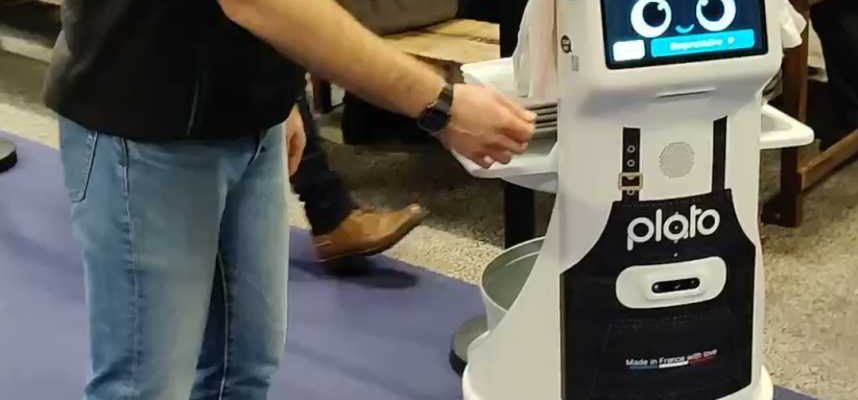He carries more than 25 plates at a time and makes multiple trips back and forth, without ever leaving his smiling face. In the living room Serbotel, one of the biggest French food industry events which runs until Wednesday evening in Nantes, a waiter barely more than a meter high is causing a sensation. His name: Plato. Its particularity: it is a robot, designed a year ago by Aldebarana French company renowned for its humanoid inventions (the robots Nao and Pepper were already there).
Plato is a “service assistant”, meaning it was developed to “help” catering teams. Mounted on wheels, it moves alone, or following an employee step by step, while avoiding obstacles. It does not speak, cannot manipulate objects, but can receive up to 30 kg of load on its platforms. “It’s very easy to use,” assures Anis Ben Mahmoud, commercial director of United Rototics Group, owner of Aldebaran. Plato is controlled using a screen, tablet or voice. He carries out routes which are recorded or captured live, from the kitchen to a table for example, or from the dining room to the dishwashing room. » Main interest? “It is made to swallow the kilometers while carrying a load. A painful task with no added value for humans. The sector also cannot find enough people to do this work. Robotics can be a solution,” is convinced Anis Ben Mahmoud.
“I think it breaks the relationship”
A few meters from the Aldebaran stand, the Bistrot des Toqués, which serves around 300 covers per day during the Serbotel show, is testing the Plato robot. Karine, one of the waitresses, judges the experience “very positive”. “It saves me a considerable number of steps with heavy plates in my hand. It saves me time. I would like to keep it beyond the living room. Plus, the customers seem very amused to see him. » Sitting next door, Syham and Jean-Baptiste are indeed intrigued by the journeys of the little humanoid. But not necessarily seduced. “I think it breaks the relationship with customers. I have the impression that the waitress comes to see us less because of the presence of the robot,” considers Jean-Baptise. “It’s funny to see him wandering around, you have to admit,” says Syham, sitting opposite. I would like one at home. But in a restaurant, no. We can say what we want, it still does a task that a human person could do. I clearly see the interest of the business manager, less that of the employees and customers. »
Sold at a price of 18,500 euros or rented from 700 euros per month, Plato currently equips around ten French restaurants, including the Le Méridien hotel in Paris, according to United Rototics Group. The latter hopes to multiply the number of copies in circulation tenfold within a year. However, a handful of other server robots had arrived on the French market before it. Imported from China, where they developed thanks to the Covid-2019 crisis, these models have functionalities similar to the Franco-German robot. In Château-Gontier (Mayenne), the restaurant-pizzeria The House has been renting one since April. “It is intelligent, easy to program and recharge,” appreciates Michael Di Costanzo, the boss. It allows you to send large tables and clear things out. He is a companion who relieves the team. It pleases the majority of customers. Some even told us that they had come on purpose for the robot. »
“The robot is just a work tool”
Aren’t these qualities likely to make it easier to replace human employees? “For us, table service, collecting cutlery, remains the unique mission of our employees,” says Michael Di Costanzo. The robot is just a work tool. But someone could indeed very well imagine a concept where robots would be the only ones at the service. Customers would collect the dishes themselves and drop off their empty plates. It would be entirely possible. Even a good idea given the enormous recruitment difficulties. However, this requires having a suitable place, spacious enough, without steps, without too many corners. » “The robot is not intended to replace the waiter but to save him time to do something else: say a word to customers, bring a carafe of water, hand out bread… All these little touches that make the difference during a service,” insists the commercial director of United Rototics Group.
National Vice President of Group of hotels and restaurants (GHR), Catherine Quérard admits that the use of robots “raises concern within the profession”, as does artificial intelligence. However, she sees “no disadvantage” if it involves “removing arduousness” and “improving business performance”. She doesn’t believe they will replace humans. “We are in a contact business, the relationship with the customer will remain fundamental. It will always be the way a waiter welcomes you, talks to you about a dish, which will make you want to come back,” she is convinced.

At the Serbotel salon, Antoine Caupert gives almost the same speech. He does not sell a robot server but a machine that makes cocktails. In 15 seconds, this sophisticated box can serve, to the milliliter, up to 300 pre-recorded mixes. “With this tool, anyone on the staff can serve a quality cocktail without mixology training. It’s a real asset for an establishment’s menu,” explains the account manager of the Montpellier-based company. Time Shaker. More than 400 customers are equipped in France. “Some bartenders tell us that they can no longer do without it. While the cocktail is being launched, they will be able to serve a coffee, cash a customer or prepare a signature cocktail,” argues Antoine Caupert. “I’m not sure this is the future,” grumbles a customer attending a demonstration. I don’t want to watch a box or a screen serve me a drink. »

